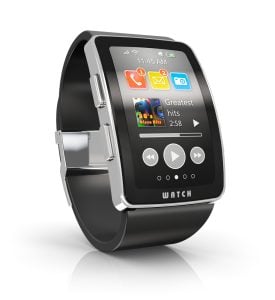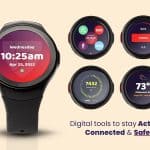
Wearable technology, like a smartwatch, can improve health and wellness as we age.
When it comes to finding new ways to keep older adults safer and more engaged at home, companies are always looking for new technology to aid in the task. Thanks to advances in the past few decades, older adults can now receive instant support from trained professionals if they are lost, if they fall, or if they need emergency assistance. Seniors can also connect more easily with family caregivers, keeping everyone on the same page when it comes to their health and needs.
While all types of technology are certainly valuable in the effort to keep seniors safer at home for as long as possible, wearable technology seems to be the most popular. Wearable devices, like watches and pendants, are convenient, easy to use, and effective. The Life Alert cost is also affordable.
Here’s more about what you should know about wearable technology and how it is improving the lives of seniors.
Better Tech for Seniors Means Simplifying Tech for All
Technology must be easy to use and effective in order for people to actually use it. As the market aims to create devices that people will use and continue to use, appealing to older adults becomes the measuring standard as to how long a specific piece of technology will stay around.
It’s no wonder why, since the population across America is aging. The United States Census Bureau tells us that the 65 and older population has grown more than 34% since 2010. Just between the years 2018 and 2019, that demographic increased by 3%. What does this mean? By 2030, one in every five Americans will be over the age of 65.
This 65 and older demographic is an important one to technology companies. If companies develop technology that is unapproachable or doesn’t meet the needs of older Americans, they alienate at least one-third of their potential customers.
This means that tech companies are paying close attention to what older adults need, what they want, and how they like to use devices. Simple changes like easy-to-understand navigation, larger buttons to click, and quick feedback can make a big difference when it comes to inviting seniors to engage with technology. But these changes can also benefit every user of every age.
We are seeing technology adapting to what older adults need and want, but without catering specifically to that older population. The Apple Watch, for example, is still sleek enough for anyone to use but has specific features that improve its usability among older adults.
How Can Technology Improve Our Lives as We Age?
Using technology effectively allows anyone to be healthier or be more connected. When used correctly, technology devices can support us as we age as well. Since the majority of older adults prefer to remain at home for as long as possible, technology can often support seniors and their family or professional caregivers in order to meet that goal.
Here are just a few ways how the right technology can improve quality of life and health as we age.
Improve Caregiver Effectiveness
Many older adults use family or professional caregivers for support, socialization, and assistance when living at home. Caregivers, whether family or professional, are juggling many tasks and often wearing many hats which can create the perfect environment for a mishap or mistake that can lead to serious consequences.
Technology has a solution. Actually, it has several.
Now that technology has entered the caregiver space, it is common to find professional caregivers using caregiver apps to keep track of personalized information for clients and documenting everything from assistance to diet to medications on one centralized app. This process can help agency supervisors to notice trends or potential concerns before an emergency situation arises.
For family caregivers, apps or other devices can connect them to their loved ones and help them learn more about what is happening when their loved one is at home. For example, a missed medication alert can be sent to a daughter in California if her dad in New York doesn’t interact with the automatic pill dispenser in his home. Family caregivers can follow up on potential emergency situations earlier and ensure their loved one’s safety.
Increase Accessibility
Getting to and from medical appointments outside of the home can become more difficult as you age. Whether due to mobility problems, decreased immune response, transportation issues, or other challenges, it is not always easy to jump in the car and head to a doctor check-up or follow-up visit.
Technology can stand in the gap and make medical attention and follow up more accessible for everyone.
For example, telehealth systems have allowed seniors the opportunity to remain at home and connect with their physician via a phone call or video conference chat. While only some older adults had taken advantage of telehealth solutions prior to 2020, the COVID-19 pandemic created the perfect environment for more older adults to try it out.
Facilitate Healthy Aging at Home
Aging in place, or staying at home (whatever “home” is to that person) for as long as possible, is often the goal for most seniors. However, it has not always been possible as health conditions increase. Seniors at home are more likely to become isolated, which can lead to many mental and physical health complications. Further, seniors at home are not always able to get out and take part in community-based resources for healthy aging.
Technology can provide a way for adults to remain connected to services, support, and resources in their community. It can also offer doctors more information about the older adult’s daily life so they can act in a preventative fashion instead of waiting for a medical crisis to occur.
Improve Early Detection and Early Intervention
Technology, especially wearable technology, can give insight into what is actually happening in the lives of seniors who live at home. Generally speaking, older adults are not always great reporters to their physicians or family members, often leaving important incidents or symptoms out of their conversation.
However, technology can help to provide that information so that doctors are able to change treatment as needed. For example, a wearable device that monitors heart rate can provide key details to a physician about why a senior is feeling lightheaded throughout the day. Similarly, a device can give information about how a person is sleeping, which can give a doctor key details they would not have otherwise.
Revolutionize Data Collection
When a simple app or device is able to give vital information to physicians, it makes healthcare a lot more personal. The more personalized care is, the better it will work. Technology, especially wearable technology, allows for that type of data collection and follow-up care.
The Endless Possibilities of Wearable Technology in Healthcare
Wearable technology, such as pendants, watches, or patches, can give real-time information to clinicians. The technology can also allow patients to feel empowered and give them easy access to their providers in case of emergency.
Why Wearables Are So Powerful
When a person can put on a piece of technology, the technology becomes even more powerful. For example, your fitness tracker is always there to remind you to get moving or take the stairs so that you can meet your step goal for the day. Similarly, having a patch that monitors your vital signs throughout the day can make you feel more at ease knowing your physician is watching your personalized results. Wearable devices are also quite affordable, giving most people the opportunity to use them.
Why the Wrist?

Can the right wearable device encourage healthier habits and choices? Absolutely.
Many wearable devices are some spin on the watch. There’s a reason for that. People have known that the wrist is the ideal place for information for many years, which is why wristwatches were first introduced.
Having a device on the wrist allows for a quick check of information without needing to stop activity or pull out a device. The wrist also has veins and arteries that make monitoring heart rate or blood pressure easier to pick up. Also, a device on the wrist does not impede movement and allows the wearer to move freely and normally.
Healthcare Providers are Big Fans
It’s not just adults and caregivers who are finding wearable technology to be convenient and useful. Clinicians and other healthcare providers are fans too. About half of surveyed providers found wearable technology helpful in monitoring their patients. The providers are able to use the information to encourage healthier habits, treat certain conditions, or follow up on any concerns.
Of course, there are frustration points that come with wearable technology. For example, patients not wearing the device properly can limit feedback, and there is still a lot of conversation about how this type of data collection can meet patient privacy standards.
Preventative Healthcare vs. Medical Treatment
Wearable technology is most effective in spurring on healthier habits or lifestyle choices in the wearer. For example, a smartwatch that tracks steps can encourage the user to lace up their shoes at a stroll around the block instead of relaxing on the couch. A watch can even help users experiment with their bedtime routine to maximize sleep quality, drink more water, or to meditate more to decrease stress. This type of preventative approach can be effective for users who might struggle with internal motivation.
However, a smart watch or other medical wearable device is not just for preventative treatments or to boost healthy habits. Devices can also be used for targeted medical treatment, such as for blood-sugar monitoring. It’s important to note that a smartwatch cannot and should not take the place of a physician in the lives of the user.
Results
When it comes to changing behaviors, a wearable device can foster a positive short-term effect. However, the challenge comes over time as the user needs to be consistent with their positive changes. Staying connected to their physician can increase the likelihood that their good behaviors will continue.
Tech Devices Help Seniors Live Happier and Healthier Lives
Technology gives us the opportunity to live healthier and happier lives. It also allows seniors to be safer and stay at home longer. Here are a few devices that can make a big difference in the lives of older adults:
Medication Dispensers: Automated medication dispensers are making the traditional pillbox obsolete. These machines are able to alert older adults when it is time to take a medication as well as dispense it. Then, if the user doesn’t take a medication, an alert message can be texted to a family caregiver for follow up. Check out Hero Health as an example.
Fall Detection Technology: Today’s medical alert bracelets or pendants are now able to detect potential falls. Once detected, the device can ask the wearer if they are in need of emergency assistance. Without a follow-up answer, the device can alert emergency responders to the wearer’s location thanks to GPS technology.
Caregiver Connections: Wearable and household technology is allowing family caregivers to be easily connected with their loved ones. Using devices that are already in most homes, companies are finding new ways to alert family caregivers about potential issues so they can follow up appropriately.
Caregiver Health: Healthy caregivers are better caregivers. There’s been a new focus within wearable technology to provide professional and family caregivers with the tools they need to care for themselves.
Conclusion
Technology is continuing to adapt and change to meet the needs of the aging American population. Thanks to wearable devices that are easy to use and effective, more older adults are feeling empowered and safe while living at home longer.


